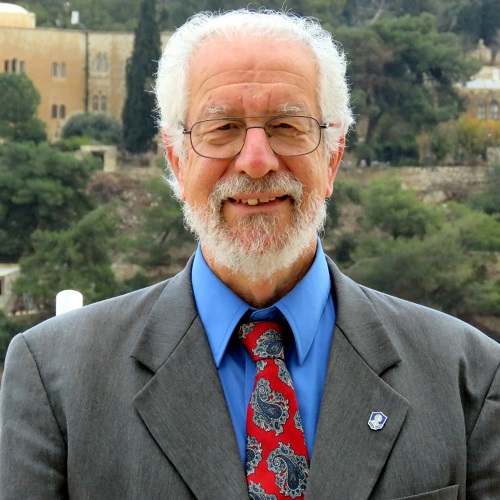Temple Mount Control Could Be Decided Between Israel, Jordan and Saudi Arabia
Israel’s Minister for National Security Itamar Ben-Gvir on Tuesday morning ascended to the Temple Mount and entered the compound, known as the Haram A-Sharif to Muslims. He walked the route that permits a Jew who observes ritual law to avoid those areas which are still considered sacred by Israel’s Chief Rabbinate. Still, the Palestinian Authority’s Wafa news agency reported that Ben-Gvir had “stormed the courtyards of the blessed Al-Aqsa Mosque through the Mughrabi Gate.” Jordan’s official Petra news agency also referred to the Ben-Gvir visit as “storming” the site and said it violated the “sanctity of Al-Aqsa.”
There were no incidents, most probably due to the element of surprise, since the media reported the previous evening that Prime Minister Binyamin Netanyahu had persuaded the new government minister to postpone his visit.
In undertaking the visit, Ben-Gvir, who has been visiting the Temple Mount – Judaism’s most holy site – monthly for years and had no intention of stopping even after becoming a government minister, fulfilled a declaration that he had made a few days earlier.
That intention was sharply criticized by Opposition Leader Yair Lapid who said, “Itamar Ben-Gvir cannot be allowed to ascend Temple Mount, it’s a provocation that will lead to deadly violence and will cost lives.” Lapid added that “this is dangerous. It is not by chance that ministers have been avoiding going to Temple Mount for many years. Knesset members may, but ministers may not. Certainly not the minister in charge of the police.”
The Temple Mount has been a flashpoint of the Arab-Israel conflict ever since 1967, when Israel Defense Forces paratroopers were able to advance into the Old City of Jerusalem and gain control from Jordanian soldiers of the Temple Mount and the Western Wall. Rabbinic authorities have prohibited total entry by Jews to any area inside the walled precinct for centuries, even as individuals and minority opinions by Torah scholars over the past 150 years have promoted restricted entrance. Even before the emergence of political Zionism, a rebuilt Temple has always been the symbol of the full Jewish return to the Land of Israel, the historic national home of the Jewish people.
However, following Israel’s capture of the Temple Mount, then-Defense Minister Moshe Dayan sat down with the Waqf Muslim Trust officials in Al-Aqsa Mosque on June 17 and, as Yossi Klein Halevi describes, “formally returned the Mount to their control. While Israeli soldiers would determine security and stand at the gates, the Waqf would determine who prayed at the site, an arrangement that would effectively bar non-Muslim prayer.” Halevi observes that “in ceding the right of Jews to pray on the Mount, Dayan’s intention was to minimize bloodshed and prevent the Palestinian-Israeli conflict from becoming a holy war.”
Give the gift of hope
We practice what we preach:
accurate, fearless journalism. But we can't do it alone.
- On the ground in Gaza, Syria, Israel, Egypt, Pakistan, and more
- Our program trained more than 100 journalists
- Calling out fake news and reporting real facts
- On the ground in Gaza, Syria, Israel, Egypt, Pakistan, and more
- Our program trained more than 100 journalists
- Calling out fake news and reporting real facts
Join us.
Support The Media Line. Save democracy.


In 2013, Palestinian Authority President Mahmoud Abbas and Jordan’s King Abdullah signed an agreement under which even the Palestinian Authority awards Jordan the recognition of that “custodianship.” This is the “historic status quo.”
Netanyahu himself confirmed his commitment to that policy on October 24, 2015 after meeting then-US Secretary of State John Kerry and King Abdullah when he stated that “Israel will continue to enforce its longstanding policy: Muslims pray on the Temple Mount; non-Muslims visit the Temple Mount.” His spokesman made clear that “Israel fully respects the special role of the Hashemite Kingdom of Jordan, as reflected in their 1994 peace treaty…[and] has no intention of dividing the Temple Mount/Haram al-Sharif.”
The increased efforts of the small numbers of Jews who had been promoting Jewish prayer at the site with the backing of greater numbers of rabbis occurred after the three-year closure of the Temple Mount to all non-Muslims between 2000 and 2003 as a result of the second intifada, or Palestinian uprising against Israel. What had been viewed as a fringe activity and viewpoint altered dramatically when the stark actuality set in of the very real possibility that Jews would forever be banned from the compound. Meanwhile, for the Arabs of the Palestinian Authority as well as the more extreme Islamist forces in Israel, led by Sheikh Raed Salah – the leader of the hardline Northern Branch of the Islamic Movement in Israel, the situation at the Temple Mount became a mobilizing instrument with the rallying cry of “Al-Aqsa is in danger.”
Jewish Temple Mount activists have based their rights and demands on the 1967 Law for the Protection of Holy Places, which guarantees free access and worship. However, Israel’s governments have always claimed primacy privilege to prevent disturbances to the public order, a position with which the High Court of Justice has agreed, although – in principle – the justices have confirmed the right of silent prayer. In essence, this outlook permits the threat of violence by Muslims to dictate an override of Jewish rights.
For the activists, therefore, any suggestion, either by Israeli politicians or Jordan or various terror groups such as Hamas, that these visits are somehow “provocations” are rejected outright. The right to visit the Temple Mount and respect it is fundamental, legal and should not be doubted nor prevented.
Jordan’s “historic role” stems from a swearing of allegiance to Abdullah’s great-great-grandfather, Hussein ibn Ali, who sought to be caliph but was forced to relinquish any claim after he was exiled from Saudi Arabia for good during that same year, 1924. But the Saudi Arabia connection has come back to haunt Jordan’s monarch.
Netanyahu has set his sights on a peace arrangement with Saudi Arabia. It is likely that transferring the so-called “custodianship” over Haram A-Sharif from the Husseinis to the Saudis will come up during the discussions. As Daniel Pipes has noted, the Saudis are seeking to enhance their international standing, as even the legitimacy of their custodianship of Mecca and Medina has been challenged, notably by Iran. If a third shrine would somehow be added to their supervision, their claims to be absolute religious leaders of the Islamic world would gain standing.
It should not be ignored, however, that Jordan’s Religious Affairs Ministry oversees the Waqf that administers the Temple Mount and funds it.
If Jordan insists on continuing its custom of terming the entrance of Jews to the Temple Mount as “stormings” and “break-ins,” the terms used in its official Foreign Ministry pronouncements and in their media, as well as financing new endowments and construction at the site, Abdullah may face an internal Arab/Muslim threat as well.


